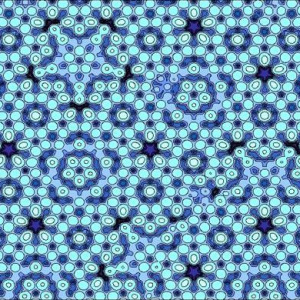−Table of Contents
Quasiperiodic crystalline materials
 Approved for use and sale Approved for use and sale |
Not so much a material as a means of arranging other materials, quasiperiodic crystalline materials or 'quasicrystals' are constructed atom by atom - giving rise to some remarkable properties which are not usually seen in nature.
Tensile strength, chemical and thermal unreactivity, flexibility are common across the board but a number of more complex properties arise from the interesting electron and photon interaction properties of the material.
Unfortunately, quasicrystalline materials can be quite expensive and difficult to repair without specialist equipment. Some example applications some materials may be able to perform include semi-conduction, thermal insulators, one-way conductors, broadcast, sensor and display systems.
Statistics
Type: Advanced materials
Designers: lazarus, Dr Aiesu Kalopsia
Nomenclature: N/A
Manufacturer: lazarus
Production: Mass Production
Fielded By: lazarus, lsdf
Availability
Quasiperiodic crystalline materials are produced by the Lazarus Consortium as of –. While not sold to the public in a raw state (there is no raw state), specialist components can be ordered on demand, similar to 3D printing.
Alternatively, since the materials existence is scientifically published, it can produced by essentially anyone - the caledfwlch is the only way to get a reliable yield and accuracy - with 0% flaws in the material. The applicator is available to the public, priced at 1800KS
This publishing does not include any specific variants, which Lazarus have patented and secured legally as a trade secret: If one were to make their own custom materials, they would have to develop it themselves.
Materials
Materials made from quasicrystals can have a wide variety of different effects, depending on their arrangement and composition. Many can be mixed and matched to produce specialist components.
- Toldedorium - An armour material able to withstand impressive punishment. Composed of Titanium boron and various allotropes of carbon.
- Phyliaus - A particular arrangement which has a number of unusual electromagnetic properties. Composed of silicon, bismuth, oxygen and various allotropes of carbon.
More about Quasiperiodic crystalline materials
Produced from studied Sourcian records, quasicrystals or quasiperiodic crystals are solid or gellatine structures built atom by atom in very specific forms which while ordered, do not repeat, removing the possibility for any energy flowing through it to build up over any single point unless especially designed to while also managing the flow of that energy, making it predictable enough to extract usefully.
This re-distribution behavior is further enhanced by the fact that quasicrystals follow not one, two, three, four or six fold repeating symmetry but up to twelve or thirty two dimensional folding symmetry in such a way that charge and force cannot be allowed to well up over a single point unless a mechanism of escape for that energy is available away from the material.
In practical terms, quasicrystals are like diodes or semi-conductors, able to extract and emit various energies matter interacts with.
Balancing out these seemingly miraculous potentials are the prohibitively high manufacturing costs and difficulty creating and maintaining the material (since it has to be built atom by atom and must be absoloutely perfect - a feat that would require vast acts of repetition - undoing mistakes and trying again - from most nanoconstructors to date with the exception of the Lazarus molecular applicator.
Commonly, it is cheaper to build the material for a specific application than general applications. If built for a specific application, it is very difficult to repurpose and most features have to either be implemented by design or through the combined use of different grains of quasicrystal together.
Field repairs are extremely difficult without the use of the molecular applicator.
OOC notes
- Written by OsakanOne.
